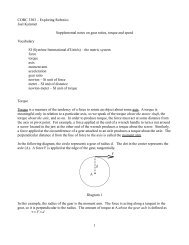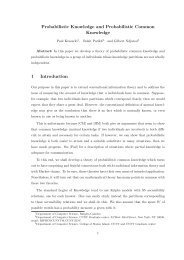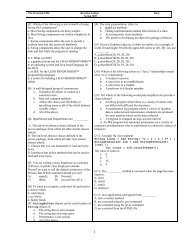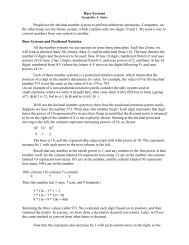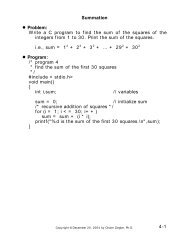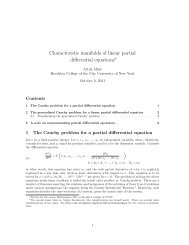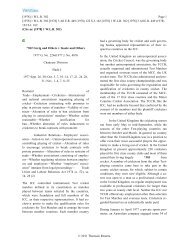The first integral of a homogeneous linear partial differential ... - CUNY
The first integral of a homogeneous linear partial differential ... - CUNY
The first integral of a homogeneous linear partial differential ... - CUNY
Create successful ePaper yourself
Turn your PDF publications into a flip-book with our unique Google optimized e-Paper software.
<strong>The</strong> <strong>first</strong> <strong>integral</strong> <strong>of</strong> a <strong>homogeneous</strong> <strong>linear</strong> <strong>partial</strong> <strong>differential</strong><br />
equation ∗<br />
Attila Máté<br />
Brooklyn College <strong>of</strong> the City University <strong>of</strong> New York<br />
September 15, 2011<br />
Contents<br />
1 <strong>The</strong> <strong>first</strong> <strong>integral</strong> 1<br />
1.1 Finding a <strong>first</strong> <strong>integral</strong> . . . . . . . . . . . . . . . . . . . . . . . . . . . . . . . . . . . 2<br />
1.2 Finding a second <strong>first</strong> <strong>integral</strong> . . . . . . . . . . . . . . . . . . . . . . . . . . . . . . . 2<br />
1 <strong>The</strong> <strong>first</strong> <strong>integral</strong><br />
Consider the <strong>partial</strong> <strong>differential</strong> equation<br />
(1) P ∂u<br />
∂x + Q∂u ∂y + R∂u ∂z = 0,<br />
where P=P(x,y,z),Q = Q(x,y,z), Q = Q(x,y,z) are given functions. A function u(x,y,z) satisfying<br />
this <strong>differential</strong> equation is also called a <strong>first</strong> <strong>integral</strong>. To find a <strong>first</strong> <strong>integral</strong>, one considers the<br />
behavior <strong>of</strong> u along curves x = x(s), y = y(s), z = z(s) satisfying the <strong>differential</strong> equations<br />
(2)<br />
dx<br />
ds = P,<br />
dy<br />
ds = Q,<br />
dz<br />
ds = R.<br />
Such a curve is called a characteristic curve <strong>of</strong> (1) or an <strong>integral</strong> curve <strong>of</strong> the vector field 〈P,Q,R〉.<br />
If u is a solution <strong>of</strong> equation (1) then u must be constant along such a curve; indeed<br />
du(x(s),y(s),z(s))<br />
ds<br />
= ∂u dx<br />
∂x ds + ∂u<br />
∂y<br />
dy<br />
ds + ∂u<br />
∂y<br />
dy<br />
ds = ∂u<br />
∂x P + ∂u<br />
∂y Q + ∂u<br />
∂z R = 0.<br />
Conversely, the following is also true: if a sufficiently smooth function u(x,y,z) is constant along<br />
every characteristic curve, then it is a solution <strong>of</strong> equation (1).<br />
∗ Written for the course Mathematics 4211 at Brooklyn College <strong>of</strong> <strong>CUNY</strong>.<br />
1
1.1 Finding a <strong>first</strong> <strong>integral</strong><br />
To find a <strong>first</strong> <strong>integral</strong>, one uses equations (2) to find a equation φ(x,y,z) = c consistent with these<br />
equations. 1 To do this, one is not interested in the parameter s in equation (2), and writes this<br />
equation in the form (see [1, pp. 24–28])<br />
(3)<br />
dx<br />
P = dy Q = dz<br />
R .<br />
<strong>The</strong> function φ(x,y,z) found in this way is constant along characteristic curves; if it were not, the<br />
equation φ(x,y,z) = c would not be consistent with equations (3). Hence u = φ(x,y,z) is a solution<br />
<strong>of</strong> equation (1), i.e., it is a <strong>first</strong> <strong>integral</strong> <strong>of</strong> this equation.<br />
Example 1. Solve the <strong>differential</strong> equation<br />
(4) u x x − u y (xz + x) − u z z = 0.<br />
Solution. Equations (3) can be written as<br />
(5)<br />
dx<br />
x = − dy<br />
xz + y = −dz z .<br />
According the <strong>first</strong> and third members <strong>of</strong> these equations we have dx/x = −dz/z, so log |x| =<br />
−log |z| + C 1 . Taking c 1 = ±e C1 , we have x = c 1 /z, i.e., xz = c 1 . That is,<br />
(6) u 1 = xz<br />
is a <strong>first</strong> <strong>integral</strong> <strong>of</strong> the equation to be solved.<br />
1.2 Finding a second <strong>first</strong> <strong>integral</strong><br />
In order to be able to find the general solution <strong>of</strong>, or the solution <strong>of</strong> an initial value problem<br />
for, equation (1), one needs to have two (functionally independent) <strong>first</strong> <strong>integral</strong>s. If one finds a<br />
<strong>first</strong> <strong>integral</strong> u 1 (x,y,z), one can use this <strong>first</strong> <strong>integral</strong> to find a second one by using the following<br />
procedure. With a constant c 1 , use the equation u 1 (x,y,z) = c 1 to simplify equations (3) (by<br />
eliminating one <strong>of</strong> the variables, for example), and then find an equation ψ(x,y,z,c 1 ) = c 2 consistent<br />
with the simplified equations. <strong>The</strong>n the function u 2 = ψ(x,y,z,u 1 (x,y,z)) will also be a <strong>first</strong> <strong>integral</strong><br />
<strong>of</strong> equation (1).<br />
Why does this method work? <strong>The</strong> equation u 1 (x,y,z) = c 1 describes a surface such that if<br />
it contains any point <strong>of</strong> a characteristic curve, then it contains the whole characteristic curve. 2<br />
<strong>The</strong>n the equation ψ(x,y,z,c 1 ) = c 2 , being consistent with equations (3) under the additional<br />
assumption that u 1 (x,y,z) = c 1 , describes a surface such that, if this surface contains any point<br />
<strong>of</strong> a characteristic curve the coordinates <strong>of</strong> which also satisfy the equation u 1 (x,y,z) = c 1 , then it<br />
contains the whole characteristic curve. 3 By allowing c 1 to assume arbitrary values, which amounts<br />
1 <strong>The</strong> word consistent is used in mathematics in the sense “not contradicting.” What that means in this case that<br />
the equation φ(x, y, z) = c must not contradict equations (2).<br />
2 This statement is only true locally, namely in a small region where the solution <strong>of</strong> the characteristic equations (2)<br />
exist and is unique, given appropriate initial conditions.<br />
3 As will be clear from the discussion below, there there is usually only one such characteristic curve. If the surface<br />
ψ(x, y, z, c 1 ) = c 2 contains a point <strong>of</strong> a characteristic curve for which the equation u 1 (x, y, z) = c 1 is not satisfied,<br />
then the whole characteristic curve need not lie in this surface; namely, this characteristic curve need not satisfy the<br />
equations obtained from (3) by using the equation u 1 (x, y, z) = c 1 . So ψ(x, y, z, c 1 ) will usually not be a <strong>first</strong> <strong>integral</strong><br />
<strong>of</strong> (1).<br />
2
to replacing c 1 with u 1 (x,y,z) in the equation ψ(x,y,z,c 1 ) = c 2 , these characteristic curves sweep<br />
out a surface. <strong>The</strong> equation <strong>of</strong> this surface is ψ(x,y,z,u 1 (x,y,z)) = c 2 . For this surface it will<br />
be true that if it contains any point <strong>of</strong> a characteristic curve, then it will contain the whole curve.<br />
<strong>The</strong>refore, u 2 = ψ(x,y,z,u 1 (x,y,z)) will be the also a <strong>first</strong> <strong>integral</strong>.<br />
Finally, the characteristic curve for which u 1 (x,y,z) = c 1 and ψ(x,y,z,c 1 ) = c 2 will be the<br />
intersection <strong>of</strong> the surfaces u 1 (x,y,z) = c 1 and u 2 (x,y,z) = c 2 . 4<br />
Solution continued. According to equation (6), the equation u 1 = c 1 becomes<br />
(7) xz = c 1 .<br />
Substituting this into the <strong>first</strong> equation in (5), we obtain<br />
dx<br />
x = − dy<br />
c 1 + y ,<br />
i.e., log |x| = −log |c 1 + y| + C 2 . Writing c 2 = ±e C2 , we obtain x = c 2 /(c 1 + y), i.e, x(c 1 + y) = c 2 .<br />
Substituting xz for c 1 as indicated by equation (7), we obtain x 2 z + xy = c 2 . Hence<br />
is another <strong>first</strong> <strong>integral</strong> <strong>of</strong> <strong>of</strong> (4).<br />
References<br />
u 2 = x 2 z + xy<br />
[1] E. C. Zachmanoglou and Dale W. Thoe. Introduction to Partial Differential Equations with<br />
Applications. Dover Publications, New York, 1986.<br />
4 So, if u 1 and u 2 are functionally independent, then there is only one such curve.<br />
3





